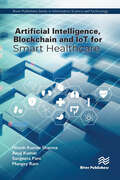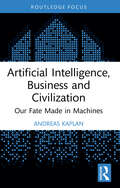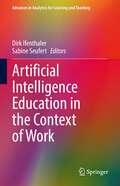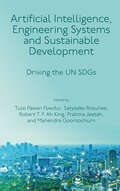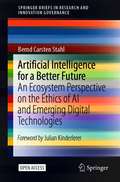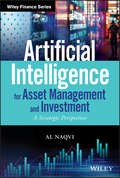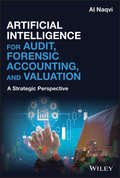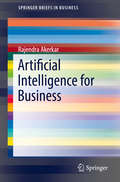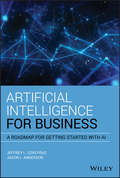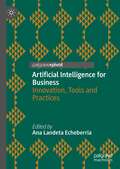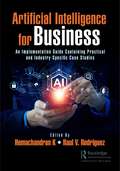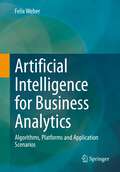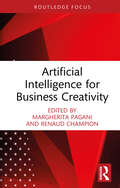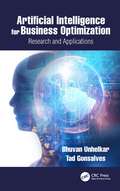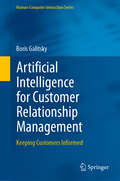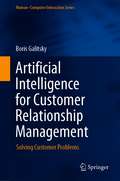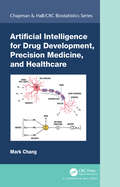- Table View
- List View
Artificial Intelligence, Blockchain and IoT for Smart Healthcare
by Hitesh Kumar Sharma Anuj Kumar Sangeeta Pant Mangey RamThe concepts of telemedicine and e-healthcare have eased as well as improved the reachability of experienced doctors and medical staff to remote patients. A patient who is living in a remote village area can directly connect to specialist doctors across the globe though his/her mobile phone using telemedicine systems and e-healthcare services. In pandemic situations like COVID-19, these online platforms helped society to get medical treatment from their residence without any physical movement. Technology is transforming human lives by playing an important role in the planning, designing, and development of intelligent systems for better service. This book presents a cross-disciplinary perspective on the concept of machine learning, blockchain and IoT by congregating cutting-edge research and insights. It also identifies and discusses various advanced technologies such as internet of things (IoT), big data analytics, machine learning, artificial intelligence, cyber security, cloud computing, sensors and so on that are vital to foster the development of smart healthcare and telemedicine systems by providing effective solutions to the medical challenges faced by humankind.
Artificial Intelligence, Business and Civilization: Our Fate Made in Machines (Routledge Focus on Business and Management)
by Andreas KaplanArtificial intelligence is shaking up economies around the world as well as society at large and is predicted to be either the best or worst thing to happen to humanity. This book looks at what exactly artificial intelligence is, how it can be classified, how it differentiates from other concepts such as machine learning, big data, blockchain, or the Internet-of-Things, and how it has evolved and might evolve over time. Providing a clear and unbiased picture of artificial intelligence, the book provides critical analyses of the advantages and disadvantages, opportunities and threats of AI progress for business and civilisation. Solutions and possible directions of how humanity might deal with rapid development and evolutions will be given and discussed, and consider regulation, employment, ethics, education and international cooperation. Unlike existing literature, this book provides a comprehensive overview of AI based on detailed analysis and insight. Finally, several real-life examples from various sectors and industries, including for profit organizations, higher education, and government, will substantiate and illustrate the presented concepts, classifications, and discussions. This book is of interest to researchers, educators, students, and practitioners alike who desire to understand AI in its broad lines and discover the latest research and studies within the field.
Artificial Intelligence, Business and Civilization: Our Fate Made in Machines (Routledge Focus on Business and Management)
by Andreas KaplanArtificial intelligence is shaking up economies around the world as well as society at large and is predicted to be either the best or worst thing to happen to humanity. This book looks at what exactly artificial intelligence is, how it can be classified, how it differentiates from other concepts such as machine learning, big data, blockchain, or the Internet-of-Things, and how it has evolved and might evolve over time. Providing a clear and unbiased picture of artificial intelligence, the book provides critical analyses of the advantages and disadvantages, opportunities and threats of AI progress for business and civilisation. Solutions and possible directions of how humanity might deal with rapid development and evolutions will be given and discussed, and consider regulation, employment, ethics, education and international cooperation. Unlike existing literature, this book provides a comprehensive overview of AI based on detailed analysis and insight. Finally, several real-life examples from various sectors and industries, including for profit organizations, higher education, and government, will substantiate and illustrate the presented concepts, classifications, and discussions. This book is of interest to researchers, educators, students, and practitioners alike who desire to understand AI in its broad lines and discover the latest research and studies within the field.
Artificial Intelligence Education in the Context of Work (Advances in Analytics for Learning and Teaching)
by Dirk Ifenthaler Sabine SeufertThis edited volume remedies existing deficiencies in the literature on artificial intelligence and education in the context of work. The topics addressed by this book are: • Supporting formal and informal learning through AI• Human-machine collaboration for learning at the workplace, including the potential of human-AI interaction in professional and vocational education contexts, design, use, and evaluation of human-AI hybrid systems for learning• Intelligent and Interactive Technologies for Learning, including natural language processing and speech technologies; data mining and machine learning; knowledge representation and reasoning; semantic web technologies, chat bot-mediated learning, and conversational learning, • AI-enabled applications for skills management and personalized learning, such as AI-enabled coaching, personalized skill management, and intelligent tutoring systems. • Case studies for the implementation and use of AI-enabled learning and performance solutions, such as personal learning experience platforms, and automated performance feedback.
Artificial Intelligence, Engineering Systems and Sustainable Development: Driving the UN SDGs
by Tulsi Pawan Fowdur Satyadev Rosunee Robert T. F. Ah King Pratima Jeetah Mahendra GooroochurnDevelopment in any country is impossible if reliable and affordable energy, safe water and sanitation, as well as telecommunication facilities, are not easily accessible. Artificial intelligence and machine learning techniques are now widely used in all branches of engineering to build and optimize systems. The combination of AI and engineering can indeed act as a real catalyst to achieve the UN SDGs. The volume editors present an analysis of different concepts and case studies in engineering disciplines such as chemical, civil, electrical, telecommunications and mechanical engineering, demonstrating how engineering systems and processes can leverage the power of AI to drive and achieve the UN SDGs. Topics covered include sustainable crop production and consumption, AI based clean water and sanitation monitoring, intelligent transport systems and achieving affordable and clean energy through AI and 5G powered internet of energy. Such a study is of paramount importance and is a valuable source of information for researchers, engineers, and policy makers to be able to better design and adopt AI enabled techniques in different engineering areas, with a view to catalyze the achievement of the UN SDGs.
Artificial Intelligence, Engineering Systems and Sustainable Development: Driving the UN SDGs
by Tulsi Pawan Fowdur, Satyadev Rosunee, Robert T. F. Ah King, Pratima Jeetah and Mahendra GooroochurnDevelopment in any country is impossible if reliable and affordable energy, safe water and sanitation, as well as telecommunication facilities, are not easily accessible. Artificial intelligence and machine learning techniques are now widely used in all branches of engineering to build and optimize systems. The combination of AI and engineering can indeed act as a real catalyst to achieve the UN SDGs. The volume editors present an analysis of different concepts and case studies in engineering disciplines such as chemical, civil, electrical, telecommunications and mechanical engineering, demonstrating how engineering systems and processes can leverage the power of AI to drive and achieve the UN SDGs. Topics covered include sustainable crop production and consumption, AI based clean water and sanitation monitoring, intelligent transport systems and achieving affordable and clean energy through AI and 5G powered internet of energy. Such a study is of paramount importance and is a valuable source of information for researchers, engineers, and policy makers to be able to better design and adopt AI enabled techniques in different engineering areas, with a view to catalyze the achievement of the UN SDGs.
Artificial Intelligence for a Better Future: An Ecosystem Perspective on the Ethics of AI and Emerging Digital Technologies (SpringerBriefs in Research and Innovation Governance)
by Bernd Carsten StahlThis open access book proposes a novel approach to Artificial Intelligence (AI) ethics. AI offers many advantages: better and faster medical diagnoses, improved business processes and efficiency, and the automation of boring work. But undesirable and ethically problematic consequences are possible too: biases and discrimination, breaches of privacy and security, and societal distortions such as unemployment, economic exploitation and weakened democratic processes. There is even a prospect, ultimately, of super-intelligent machines replacing humans. The key question, then, is: how can we benefit from AI while addressing its ethical problems?This book presents an innovative answer to the question by presenting a different perspective on AI and its ethical consequences. Instead of looking at individual AI techniques, applications or ethical issues, we can understand AI as a system of ecosystems, consisting of numerous interdependent technologies, applications and stakeholders. Developing this idea, the book explores how AI ecosystems can be shaped to foster human flourishing. Drawing on rich empirical insights and detailed conceptual analysis, it suggests practical measures to ensure that AI is used to make the world a better place.
Artificial Intelligence for Asset Management and Investment: A Strategic Perspective (Wiley Finance)
by Al NaqviMake AI technology the backbone of your organization to compete in the Fintech era The rise of artificial intelligence is nothing short of a technological revolution. AI is poised to completely transform asset management and investment banking, yet its current application within the financial sector is limited and fragmented. Existing AI implementations tend to solve very narrow business issues, rather than serving as a powerful tech framework for next-generation finance. Artificial Intelligence for Asset Management and Investment provides a strategic viewpoint on how AI can be comprehensively integrated within investment finance, leading to evolved performance in compliance, management, customer service, and beyond. No other book on the market takes such a wide-ranging approach to using AI in asset management. With this guide, you’ll be able to build an asset management firm from the ground up—or revolutionize your existing firm—using artificial intelligence as the cornerstone and foundation. This is a must, because AI is quickly growing to be the single competitive factor for financial firms. With better AI comes better results. If you aren’t integrating AI in the strategic DNA of your firm, you’re at risk of being left behind. See how artificial intelligence can form the cornerstone of an integrated, strategic asset management framework Learn how to build AI into your organization to remain competitive in the world of Fintech Go beyond siloed AI implementations to reap even greater benefits Understand and overcome the governance and leadership challenges inherent in AI strategy Until now, it has been prohibitively difficult to map the high-tech world of AI onto complex and ever-changing financial markets. Artificial Intelligence for Asset Management and Investment makes this difficulty a thing of the past, providing you with a professional and accessible framework for setting up and running artificial intelligence in your financial operations.
Artificial Intelligence for Asset Management and Investment: A Strategic Perspective (Wiley Finance)
by Al NaqviMake AI technology the backbone of your organization to compete in the Fintech era The rise of artificial intelligence is nothing short of a technological revolution. AI is poised to completely transform asset management and investment banking, yet its current application within the financial sector is limited and fragmented. Existing AI implementations tend to solve very narrow business issues, rather than serving as a powerful tech framework for next-generation finance. Artificial Intelligence for Asset Management and Investment provides a strategic viewpoint on how AI can be comprehensively integrated within investment finance, leading to evolved performance in compliance, management, customer service, and beyond. No other book on the market takes such a wide-ranging approach to using AI in asset management. With this guide, you’ll be able to build an asset management firm from the ground up—or revolutionize your existing firm—using artificial intelligence as the cornerstone and foundation. This is a must, because AI is quickly growing to be the single competitive factor for financial firms. With better AI comes better results. If you aren’t integrating AI in the strategic DNA of your firm, you’re at risk of being left behind. See how artificial intelligence can form the cornerstone of an integrated, strategic asset management framework Learn how to build AI into your organization to remain competitive in the world of Fintech Go beyond siloed AI implementations to reap even greater benefits Understand and overcome the governance and leadership challenges inherent in AI strategy Until now, it has been prohibitively difficult to map the high-tech world of AI onto complex and ever-changing financial markets. Artificial Intelligence for Asset Management and Investment makes this difficulty a thing of the past, providing you with a professional and accessible framework for setting up and running artificial intelligence in your financial operations.
Artificial Intelligence for Audit, Forensic Accounting, and Valuation: A Strategic Perspective
by Al NaqviStrategically integrate AI into your organization to compete in the tech era The rise of artificial intelligence is nothing short of a technological revolution. AI is poised to completely transform accounting and auditing professions, yet its current application within these areas is limited and fragmented. Existing AI implementations tend to solve very narrow business issues, rather than serving as a powerful tech framework for next-generation accounting. Artificial Intelligence for Audit, Forensic Accounting, and Valuation provides a strategic viewpoint on how AI can be comprehensively integrated within audit management, leading to better automated models, forensic accounting, and beyond. No other book on the market takes such a wide-ranging approach to using AI in audit and accounting. With this guide, you’ll be able to build an innovative, automated accounting strategy, using artificial intelligence as the cornerstone and foundation. This is a must, because AI is quickly growing to be the single competitive factor for audit and accounting firms. With better AI comes better results. If you aren’t integrating AI and automation in the strategic DNA of your business, you’re at risk of being left behind. See how artificial intelligence can form the cornerstone of integrated, automated audit and accounting services Learn how to build AI into your organization to remain competitive in the era of automation Go beyond siloed AI implementations to modernize and deliver results across the organization Understand and overcome the governance and leadership challenges inherent in AI strategy Accounting and auditing firms need a comprehensive framework for intelligent, automation-centric modernization. Artificial Intelligence for Audit, Forensic Accounting, and Valuation delivers just that—a plan to evolve legacy firms by building firmwide AI capabilities.
Artificial Intelligence for Audit, Forensic Accounting, and Valuation: A Strategic Perspective
by Al NaqviStrategically integrate AI into your organization to compete in the tech era The rise of artificial intelligence is nothing short of a technological revolution. AI is poised to completely transform accounting and auditing professions, yet its current application within these areas is limited and fragmented. Existing AI implementations tend to solve very narrow business issues, rather than serving as a powerful tech framework for next-generation accounting. Artificial Intelligence for Audit, Forensic Accounting, and Valuation provides a strategic viewpoint on how AI can be comprehensively integrated within audit management, leading to better automated models, forensic accounting, and beyond. No other book on the market takes such a wide-ranging approach to using AI in audit and accounting. With this guide, you’ll be able to build an innovative, automated accounting strategy, using artificial intelligence as the cornerstone and foundation. This is a must, because AI is quickly growing to be the single competitive factor for audit and accounting firms. With better AI comes better results. If you aren’t integrating AI and automation in the strategic DNA of your business, you’re at risk of being left behind. See how artificial intelligence can form the cornerstone of integrated, automated audit and accounting services Learn how to build AI into your organization to remain competitive in the era of automation Go beyond siloed AI implementations to modernize and deliver results across the organization Understand and overcome the governance and leadership challenges inherent in AI strategy Accounting and auditing firms need a comprehensive framework for intelligent, automation-centric modernization. Artificial Intelligence for Audit, Forensic Accounting, and Valuation delivers just that—a plan to evolve legacy firms by building firmwide AI capabilities.
Artificial Intelligence for Business (SpringerBriefs in Business)
by Rajendra AkerkarThis book offers a practical guide to artificial intelligence (AI) techniques that are used in business. The book does not focus on AI models and algorithms, but instead provides an overview of the most popular and frequently used models in business. This allows the book to easily explain AI paradigms and concepts for business students and executives. Artificial Intelligence for Business is divided into six chapters. Chapter 1 begins with a brief introduction to AI and describes its relationship with machine learning, data science and big data analytics. Chapter 2 presents core machine learning workflow and the most effective machine learning techniques. Chapter 3 deals with deep learning, a popular technique for developing AI applications. Chapter 4 introduces recommendation engines for business and covers how to use them to be more competitive. Chapter 5 features natural language processing (NLP) for sentiment analysis focused on emotions. With the help of sentiment analysis, businesses can understand their customers better to improve their experience, which will help the businesses change their market position. Chapter 6 states potential business prospects of AI and the benefits that companies can realize by implementing AI in their processes.
Artificial Intelligence for Business: A Roadmap for Getting Started with AI
by Jason L. Anderson Jeffrey L. CoveyducArtificial Intelligence for Business: A Roadmap for Getting Started with AI will provide the reader with an easy to understand roadmap for how to take an organization through the adoption of AI technology. It will first help with the identification of which business problems and opportunities are right for AI and how to prioritize them to maximize the likelihood of success. Specific methodologies are introduced to help with finding critical training data within an organization and how to fill data gaps if they exist. With data in hand, a scoped prototype can be built to limit risk and provide tangible value to the organization as a whole to justify further investment. Finally, a production level AI system can be developed with best practices to ensure quality with not only the application code, but also the AI models. Finally, with this particular AI adoption journey at an end, the authors will show that there is additional value to be gained by iterating on this AI adoption lifecycle and improving other parts of the organization.
Artificial Intelligence for Business: A Roadmap for Getting Started with AI
by Jason L. Anderson Jeffrey L. CoveyducArtificial Intelligence for Business: A Roadmap for Getting Started with AI will provide the reader with an easy to understand roadmap for how to take an organization through the adoption of AI technology. It will first help with the identification of which business problems and opportunities are right for AI and how to prioritize them to maximize the likelihood of success. Specific methodologies are introduced to help with finding critical training data within an organization and how to fill data gaps if they exist. With data in hand, a scoped prototype can be built to limit risk and provide tangible value to the organization as a whole to justify further investment. Finally, a production level AI system can be developed with best practices to ensure quality with not only the application code, but also the AI models. Finally, with this particular AI adoption journey at an end, the authors will show that there is additional value to be gained by iterating on this AI adoption lifecycle and improving other parts of the organization.
Artificial Intelligence for Business: Innovation, Tools and Practices
by Ana Landeta EcheberriaThis book seeks to build a shared understanding of Artificial Intelligence (AI) within the global business scenario today and in the near future. Drawing on academic theory and real-world case studies, it examines AI’s development and application across a number of business contexts.Taking current scholarship forward in its engagement with AI theory and practice for enterprises and applied research and innovation, it outlines international practices for the promotion of reliable AI systems, trends, research and development, fostering a digital ecosystem for AI and preparing companies for job transformation and building skills.This book will be of great interest to academics studying Digital Business, Digital Strategy, Innovation Management, and Information Technology.
Artificial Intelligence for Business: An Implementation Guide Containing Practical and Industry-Specific Case Studies
by K Hemachandran Raul V. RodriguezArtificial intelligence (AI) is transforming the business world at an unprecedented pace. From automating mundane tasks to predicting consumer behaviour, AI is changing the way businesses operate across all sectors. This book is an exploration of AI in business applications, highlighting the diverse range of ways in which AI is being used across different industries. The book begins with an overview of AI in business and its impact on the workforce. It then explores the role of AI in marketing, advertising, and tourism. The use of AI in personalized recommendations and chatbots is discussed in detail. The book then moves on to examine how AI is changing the retail industry, improving supply chain management, and enhancing the customer experience. The media and entertainment industry is also examined, with a focus on how AI is being used to personalize content and improve the user experience. The book also explores the use of AI in human resources, insurance, legal, and finance. The impact of AI on talent identification, recruitment, underwriting, document analysis, and financial forecasting is discussed in detail. In the healthcare and sports industries, AI is transforming the way we approach diagnosis, treatment, and training. The book examines how AI is being used to analyse medical images, develop personalized treatment plans, and improve patient outcomes. The use of AI in sports performance analysis is also discussed in detail. Finally, the book explores the use of AI in agriculture, energy, education, and the public sector. The potential of AI to optimize crop yields, reduce energy consumption, and improve the quality of education is discussed in detail. The book also examines how AI is being used to improve public services, such as transportation and emergency services. This book is a valuable resource for academics, researchers, professionals, and policymakers who are interested in understanding the potential of AI in the business world. The contributions from leading experts and researchers provide a comprehensive overview of AI in business applications, and how it is transforming different sectors. The book also examines the ethical dilemmas that arise from the use of AI in business, such as the impact on privacy and data security, and the potential for bias in AI algorithms. It provides valuable insights into how businesses can ensure that the use of AI is ethical and responsible. In conclusion, this book is a must-read for anyone interested in the potential of AI in the business world. It provides a comprehensive overview of AI in business applications and how it is transforming different sectors. The book examines the ethical dilemmas that arise from the use of AI in business, providing valuable insights into how businesses can ensure that the use of AI is ethical and responsible. We hope that readers will find this book informative and thought-provoking.
Artificial Intelligence for Business: An Implementation Guide Containing Practical and Industry-Specific Case Studies
Artificial intelligence (AI) is transforming the business world at an unprecedented pace. From automating mundane tasks to predicting consumer behaviour, AI is changing the way businesses operate across all sectors. This book is an exploration of AI in business applications, highlighting the diverse range of ways in which AI is being used across different industries. The book begins with an overview of AI in business and its impact on the workforce. It then explores the role of AI in marketing, advertising, and tourism. The use of AI in personalized recommendations and chatbots is discussed in detail. The book then moves on to examine how AI is changing the retail industry, improving supply chain management, and enhancing the customer experience. The media and entertainment industry is also examined, with a focus on how AI is being used to personalize content and improve the user experience. The book also explores the use of AI in human resources, insurance, legal, and finance. The impact of AI on talent identification, recruitment, underwriting, document analysis, and financial forecasting is discussed in detail. In the healthcare and sports industries, AI is transforming the way we approach diagnosis, treatment, and training. The book examines how AI is being used to analyse medical images, develop personalized treatment plans, and improve patient outcomes. The use of AI in sports performance analysis is also discussed in detail. Finally, the book explores the use of AI in agriculture, energy, education, and the public sector. The potential of AI to optimize crop yields, reduce energy consumption, and improve the quality of education is discussed in detail. The book also examines how AI is being used to improve public services, such as transportation and emergency services. This book is a valuable resource for academics, researchers, professionals, and policymakers who are interested in understanding the potential of AI in the business world. The contributions from leading experts and researchers provide a comprehensive overview of AI in business applications, and how it is transforming different sectors. The book also examines the ethical dilemmas that arise from the use of AI in business, such as the impact on privacy and data security, and the potential for bias in AI algorithms. It provides valuable insights into how businesses can ensure that the use of AI is ethical and responsible. In conclusion, this book is a must-read for anyone interested in the potential of AI in the business world. It provides a comprehensive overview of AI in business applications and how it is transforming different sectors. The book examines the ethical dilemmas that arise from the use of AI in business, providing valuable insights into how businesses can ensure that the use of AI is ethical and responsible. We hope that readers will find this book informative and thought-provoking.
Artificial Intelligence for Business Analytics: Algorithms, Platforms and Application Scenarios
by Felix WeberWhile methods of artificial intelligence (AI) were until a few years ago exclusively a topic of scientific discussions, today they are increasingly finding their way into products of everyday life. At the same time, the amount of data produced and available is growing due to increasing digitalization, the integration of digital measurement and control systems, and automatic exchange between devices (Internet of Things). In the future, the use of business intelligence (BI) and a look into the past will no longer be sufficient for most companies.Instead, business analytics, i.e., predictive and predictive analyses and automated decisions, will be needed to stay competitive in the future. The use of growing amounts of data is a significant challenge and one of the most important areas of data analysis is represented by artificial intelligence methods.This book provides a concise introduction to the essential aspects of using artificial intelligence methods for business analytics, presents machine learning and the most important algorithms in a comprehensible form using the business analytics technology framework, and shows application scenarios from various industries. In addition, it provides the Business Analytics Model for Artificial Intelligence, a reference procedure model for structuring BA and AI projects in the company.This book is a translation of the original German 1st edition Künstliche Intelligenz für Business Analytics by Felix Weber, published by Springer Fachmedien Wiesbaden GmbH, part of Springer Nature in 2020. The translation was done with the help of artificial intelligence (machine translation by the service DeepL.com). A subsequent human revision was done primarily in terms of content, so that the book will read stylistically differently from a conventional translation. Springer Nature works continuously to further the development of tools for the production of books and on the related technologies to support the authors.
Artificial Intelligence for Business Creativity (Routledge Focus on Business and Management)
by Margherita Pagani Renaud ChampionArtificial Intelligence for Business Creativity provides an in-depth examination of the integration of Artificial Intelligence (AI) into the business sector to foster creativity. The book explores the interplay between micro-level individual creativity and macro-level organizational innovation through the lens of AI. It delves into three crucial areas where AI can stimulate business creativity: product and service design, optimized processes, and enhanced organizational collaboration. The authors also highlight the versatility and capability of generative AI systems in promoting creativity and innovation. Intended for business leaders, managers, entrepreneurs, and those interested in AI and creativity, the book offers practical guidance and insightful recommendations on how organizations can effectively utilize AI to enhance their creative process. By offering a comprehensive understanding of the role of AI in fostering creativity, the book equips its readers with the tools to stay ahead in the rapidly changing landscape of AI and creativity. This book is a valuable resource for anyone seeking to understand the impact of AI on business creativity and how to effectively leverage it to foster creativity and innovation in their organization. It is a must-read for anyone looking to increase their knowledge and understanding of AI and its impact on business creativity.
Artificial Intelligence for Business Creativity (Routledge Focus on Business and Management)
by Margherita Pagani Renaud ChampionArtificial Intelligence for Business Creativity provides an in-depth examination of the integration of Artificial Intelligence (AI) into the business sector to foster creativity. The book explores the interplay between micro-level individual creativity and macro-level organizational innovation through the lens of AI. It delves into three crucial areas where AI can stimulate business creativity: product and service design, optimized processes, and enhanced organizational collaboration. The authors also highlight the versatility and capability of generative AI systems in promoting creativity and innovation. Intended for business leaders, managers, entrepreneurs, and those interested in AI and creativity, the book offers practical guidance and insightful recommendations on how organizations can effectively utilize AI to enhance their creative process. By offering a comprehensive understanding of the role of AI in fostering creativity, the book equips its readers with the tools to stay ahead in the rapidly changing landscape of AI and creativity. This book is a valuable resource for anyone seeking to understand the impact of AI on business creativity and how to effectively leverage it to foster creativity and innovation in their organization. It is a must-read for anyone looking to increase their knowledge and understanding of AI and its impact on business creativity.
Artificial Intelligence for Business Optimization: Research and Applications
by Bhuvan Unhelkar Tad GonsalvesThis is primarily a business book that discusses the research and associated practical application of artificial intelligence (AI) and machine learning (ML) in order to achieve business optimization (BO). AI comprises a wide range of technologies, databases, algorithms, and devices. This book aims for a holistic approach to AI by focusing on developing business strategies that will not only automate but also optimize business functions, processes, and people’s behaviors. Artificial Intelligence for Business Optimization: Research and Applications explores AI and ML from a business viewpoint with the key purpose of enhancing customer value. It applies research methods and fundamentals from a practitioner’s viewpoint and incorporates discussions around risks and changes associated with the utilization of AI in business. Furthermore, governance risks, privacy, and security are also addressed in this book to ensure compliance with AI/ML applications. Readers should find direct and practical applications of the discussions in this book quite useful in their work environment. Researchers will find many ideas to further explore the applications of AI to business.
Artificial Intelligence for Business Optimization: Research and Applications
by Bhuvan Unhelkar Tad GonsalvesThis is primarily a business book that discusses the research and associated practical application of artificial intelligence (AI) and machine learning (ML) in order to achieve business optimization (BO). AI comprises a wide range of technologies, databases, algorithms, and devices. This book aims for a holistic approach to AI by focusing on developing business strategies that will not only automate but also optimize business functions, processes, and people’s behaviors. Artificial Intelligence for Business Optimization: Research and Applications explores AI and ML from a business viewpoint with the key purpose of enhancing customer value. It applies research methods and fundamentals from a practitioner’s viewpoint and incorporates discussions around risks and changes associated with the utilization of AI in business. Furthermore, governance risks, privacy, and security are also addressed in this book to ensure compliance with AI/ML applications. Readers should find direct and practical applications of the discussions in this book quite useful in their work environment. Researchers will find many ideas to further explore the applications of AI to business.
Artificial Intelligence for Customer Relationship Management: Keeping Customers Informed (Human–Computer Interaction Series)
by Boris GalitskyThis research monograph brings AI to the field of Customer Relationship Management (CRM) to make a customer experience with a product or service smart and enjoyable. AI is here to help customers to get a refund for a canceled flight, unfreeze a banking account or get a health test result. Today, CRM has evolved from storing and analyzing customers’ data to predicting and understanding their behavior by putting a CRM system in a customers’ shoes. Hence advanced reasoning with learning from small data, about customers’ attitudes, introspection, reading between the lines of customer communication and explainability need to come into play.Artificial Intelligence for Customer Relationship Management leverages a number of Natural Language Processing (NLP), Machine Learning (ML), simulation and reasoning techniques to enable CRM with intelligence. An effective and robust CRM needs to be able to chat with customers, providing desired information, completing their transactions and resolving their problems. It introduces a systematic means of ascertaining a customers’ frame of mind, their intents and attitudes to determine when to provide a thorough answer, a recommendation, an explanation, a proper argument, timely advice and promotion or compensation. The author employs a spectrum of ML methods, from deterministic to statistical to deep, to predict customer behavior and anticipate possible complaints, assuring customer retention efficiently. Providing a forum for the exchange of ideas in AI, this book provides a concise yet comprehensive coverage of methodologies, tools, issues, applications, and future trends for professionals, managers, and researchers in the CRM field together with AI and IT professionals.
Artificial Intelligence for Customer Relationship Management: Solving Customer Problems (Human–Computer Interaction Series)
by Boris GalitskyThe second volume of this research monograph describes a number of applications of Artificial Intelligence in the field of Customer Relationship Management with the focus of solving customer problems. We design a system that tries to understand the customer complaint, his mood, and what can be done to resolve an issue with the product or service. To solve a customer problem efficiently, we maintain a dialogue with the customer so that the problem can be clarified and multiple ways to fix it can be sought. We introduce dialogue management based on discourse analysis: a systematic linguistic way to handle the thought process of the author of the content to be delivered. We analyze user sentiments and personal traits to tailor dialogue management to individual customers. We also design a number of dialogue scenarios for CRM with replies following certain patterns and propose virtual and social dialogues for various modalities of communication with a customer. After we learn to detect fake content, deception and hypocrisy, we examine the domain of customer complaints. We simulate mental states, attitudes and emotions of a complainant and try to predict his behavior. Having suggested graph-based formal representations of complaint scenarios, we machine-learn them to identify the best action the customer support organization can chose to retain the complainant as a customer.
Artificial Intelligence for Drug Development, Precision Medicine, and Healthcare (Chapman & Hall/CRC Biostatistics Series)
by Mark ChangArtificial Intelligence for Drug Development, Precision Medicine, and Healthcare covers exciting developments at the intersection of computer science and statistics. While much of machine-learning is statistics-based, achievements in deep learning for image and language processing rely on computer science&’s use of big data. Aimed at those with a statistical background who want to use their strengths in pursuing AI research, the book: · Covers broad AI topics in drug development, precision medicine, and healthcare. · Elaborates on supervised, unsupervised, reinforcement, and evolutionary learning methods. · Introduces the similarity principle and related AI methods for both big and small data problems. · Offers a balance of statistical and algorithm-based approaches to AI. · Provides examples and real-world applications with hands-on R code. · Suggests the path forward for AI in medicine and artificial general intelligence. As well as covering the history of AI and the innovative ideas, methodologies and software implementation of the field, the book offers a comprehensive review of AI applications in medical sciences. In addition, readers will benefit from hands on exercises, with included R code.
